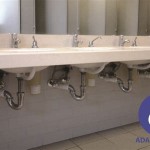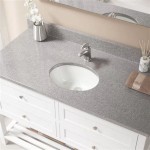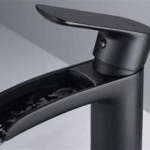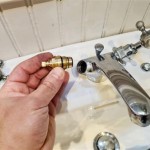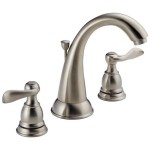How To Fix The Drain In Bathroom Sink
A clogged bathroom sink drain is a common household problem that can be frustrating and inconvenient. It's often caused by a buildup of hair, soap scum, and other debris. Fortunately, most bathroom sink drain clogs can be fixed with simple tools and techniques. This guide will provide you with the knowledge and steps necessary to diagnose and remedy a clogged bathroom sink drain effectively.
1. Identify the Cause of the Clog
Before attempting any repairs, it's crucial to identify the underlying cause of the clog. This can help determine the most effective course of action. Here are some common culprits:
- Hair and Soap Scum: This is the most frequent cause of bathroom sink clogs. Hair and soap scum accumulate over time, forming a sticky barrier that restricts water flow.
- Foreign Objects: Items like jewelry, hair ties, or small toys can easily fall down the drain and cause a blockage.
- Mineral Deposits: Hard water can leave behind mineral deposits that build up and obstruct the drain.
- Damaged Drain Trap: The drain trap, a curved pipe beneath the sink, can crack or become corroded over time, leading to leaks and clogs.
By understanding the source of the clog, you can choose the appropriate solution. For instance, if the clog is due to hair and soap scum, a simple drain cleaner or plunger might suffice. However, if a foreign object is causing the blockage, you might need to use a plumbing snake or dismantle the drain trap.
2. Attempt Basic Clearing Techniques
Before resorting to more drastic measures, try these basic cleaning techniques that are often effective for minor clogs:
2.1. Use a Plunger
A plunger is a trusty tool for dislodging clogs in bathroom sinks. Here's how to use it effectively:
- Fill the sink with a small amount of water, just enough to cover the plunger's cup.
- Position the plunger's cup firmly over the drain opening, ensuring a good seal.
- Press down on the plunger handle with firm, consistent pressure, then lift it sharply.
- Repeat this pumping motion for several minutes, until the clog dislodges or the water drains freely.
If the plunger doesn't work, try creating a vacuum by covering the overflow drain with a damp cloth before plunging. This can sometimes help to dislodge the clog by increasing pressure.
2.2. Utilize a Drain Snake
For clogs that are deeper in the drain or those that the plunger can't reach, a drain snake can be a useful tool. Drain snakes are flexible, spring-like tools with a hook or a corkscrew at the end. They are inserted into the drain to break up and remove the debris causing the clog.
- Insert the drain snake into the drain opening, pushing it as far as possible.
- Rotate the handle of the drain snake clockwise, allowing the hook or corkscrew to catch and remove the obstruction.
- Pull the drain snake back out, removing any debris that was collected.
- Flush the drain with hot water to ensure it is clear.
Be careful not to push the snake too forcefully, as you could damage the drain pipes.
3. Consider Chemical Drain Cleaners
Chemical drain cleaners contain strong chemicals that can dissolve hair, grease, and other substances that cause clogs. While they can be effective, their use should be approached with caution. These chemicals can be corrosive and potentially dangerous if not handled properly.
Here are some essential safety precautions when using chemical drain cleaners:
- Always read and follow the manufacturer's instructions carefully.
- Wear protective gloves, goggles, and a mask when handling chemical cleaners.
- Ensure adequate ventilation in the area where you are using the cleaner.
- Do not mix different types of drain cleaners together.
- Never pour drain cleaner down a drain that is partially blocked or overflowing.
If the chemical drain cleaner fails to clear the clog, or if you are concerned about the safety of using these products, it's best to contact a professional plumber.
4. Accessing the Drain Trap
If the above methods are unsuccessful, the clog might be located in the drain trap beneath the sink. You may need to dismantle the trap to remove the obstruction. Here's how to do it:
- Place a bucket or a large container beneath the drain trap to catch any water that may spill.
- Use a wrench to loosen the nuts on both ends of the drain trap. Be careful not to overtighten the nuts.
- Remove the drain trap from the drain pipe.
- Clean the trap thoroughly, removing any debris or buildup.
- Reassemble the trap and reconnect it to the drain pipe.
- Tighten the nuts on both ends of the drain trap using a wrench, but be careful not to overtighten them.
- Check for leaks after reconnecting the trap by running water in the sink.
If the clog persists after cleaning the drain trap, you might need to consult a professional plumber who can diagnose and repair any underlying plumbing issues.

How To Replace A Rusty Sink Drain Howtolou Com

5 Natural Ways To Unclog A Bathroom Sink Hiller How

How To Fix A Bathroom Sink Drain Stopper 4 Easy Solutions
How To Install Bathroom Sink Drain Queen Bee Of Honey Dos

How To Replace A Bathroom Sink Drain

How To Unclog A Slow Running Bathroom Sink Drain 10 Options

How To Unclog A Bathroom Sink Hana S Happy Home
How To Install Bathroom Sink Drain Queen Bee Of Honey Dos

How To Fix A Bathroom Sink That Won T Drain Bfp Bay Area

How To Unclog A Slow Running Bathroom Sink Drain 10 Options
Related Posts
